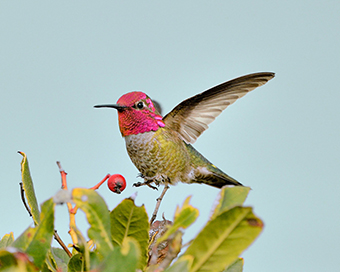
Audubon Adventures

Background for Teachers
Hummingbirds have always dazzled humans. These tiny birds, with their iridescent plumage, acrobatic flying, and pugnacious behavior, inspired mythical beliefs among the ancient Aztec and amazed Europeans arriving on New World shores. Today hummingbirds inspire us to set out hummingbird feeders and engage in community-science projects devoted to them.
Hummingbirds live only in the Western hemisphere. They are the world’s smallest birds. The smallest of all, the Bee Hummingbird, is about 2 inches long. They’re also the only birds that can truly fly backwards—as if flying up, down, and sideways and hovering in place were not enough! This aeronautical ability is powered by flight muscles that form 25 to 30 percent of a hummer’s total weight.

Hummingbirds at Home
The National Audubon Society‘s Hummingbirds at Home project is a multi-year hummingbird conservation program that enlists the help of community scientists. Audubon encourages individuals, families, and classrooms to take part. Participants are invited to survey patches that are likely to attract hummingbirds, noting what nectar sources are there as well as observations of hummingbirds feeding.
This data can then be submitted online or via a smart phone app. The information gathered will assist Audubon researchers as they investigate the implications of migrating hummingbirds and spring blooming occurring out of synch. Find out more by visiting hummingbirdsathome.org.
Hovering is energy-intensive. Being small is demanding, too: A hummer’s surface area is proportionately larger for its size than a bigger bird’s, so it loses body heat more readily. Thus a high metabolic rate is required to keep a hummer humming—the highest, in fact, of any living thing. As a result, a hummingbird needs lots of fuel. It eats about half its weight in food each day. It may spend about 15 percent of its day feeding and another 80 percent perched, digesting.
While feeding, hummingbirds play an important role as pollinators, ferrying pollen from flower to flower. About 8,000 plants in the Americas depend on hummingbirds’ pollination services. Most species will feed from many kinds of flowers, but there are some specialized plant-hummingbird partnerships. These include hummingbirds with bills of a length or shape adapted to fit a particular flower, such as the South American Sword-billed Hummingbird, with a four-inch beak suited to long datura flowers.
Little Birds, Big Journeys
Most of the more than 325 described species of hummingbirds dwell exclusively in Central and South America. Many migrate within these regions or between higher and lower altitudes but do not migrate north of Mexico. About two dozen species, however, appear in the United States. Some are vagrants—odd wanderers that show up rarely—while others regularly migrate north and even breed here. Among the 14 species that regularly breed north of Mexico are the Ruby-throated Hummingbird and the Rufous Hummingbird.
The Ruby-throated Hummingbird is the only species that commonly breeds in the eastern United States. Until the 1950s scientists dismissed the notion that Ruby-throated Hummingbirds flew nonstop across the Gulf of Mexico, migrating more than 500 miles in about 20 hours. But studies showed that not only did they make this incredible journey, they also beefed up for the task in advance by nearly doubling their weight.

Hummingbird Surprises
Birds that show up in locations where they’re not typically seen are known as vagrants. They may be birds blown off course by a storm, or yanked off course by some glitch in their genetically hardwired instincts. They may also be species adapting to new conditions and expanding their range.
Anna’s Hummingbirds, for example, were once confined to southern and Baja California. Since the 1940s, they’ve expanded their range northward. Today, they live as far north as British Columbia and are year-round residents in parts of the Pacific Northwest. It is thought that the existence of gardens full of exotic flowering plants has enabled this expansion.
Meanwhile, in the southeastern United States, reports of overwintering Rufous Hummingbirds increased starting in the 1970s. “Rufies” are historically a western species. Speculations for this behavior include food availability in suburban gardens and the evolution of a new migratory route due to genetic changes.
In the western United States, the Rufous Hummingbird migrates from Mexico to regions as far north as Alaska. Like the Ruby-throated Hummingbird, which depends on stopovers for feeding and resting, the Rufous Hummingbird follows floral pathways called “nectar corridors.” It requires a dependable supply of energy-rich nectar provided by flowering plants in these corridors.
Climate Concerns
The prospect of climate change affecting the timing of hummingbird migration and blooming of plants along nectar corridors and in breeding ranges is cause for concern. If warmer temperatures induce plants to flower earlier than usual, they could be out of bloom by the time hummingbirds arrive. Alternatively, if birds migrate earlier than usual, they could arrive before flowers bloom.
It is already documented that when drought causes nectar availability to dwindle, migrating birds must spend more time at rest stops to fuel up for the rest of the journey. A persistent lack of nectar would thus take a toll on the survival of migrating hummingbirds as well as on their reproductive success.
Are birds changing migratory behavior in response to climate change? Studies to date suggest they are. In an Audubon "State of the Birds" report, for example, an analysis of 305 bird species that winter in North America found that in recent years nearly 60 percent have shifted their winter range northward by an average of 35 miles (based on figures from the long-running Christmas Bird Count community-science project). Likewise, a recent analysis by researchers at Clemson University using archival data and community-science reporting suggests that Ruby-throated Hummingbirds are arriving on breeding grounds up to two weeks earlier than they were a century ago.
New studies linking climate data with changes in plant growth and animal behavior are underway. NASA, for example, is partnering with research institutions to link climate study with biological studies. Among the projects is one focusing on hummingbirds as “indicator species.” Hummingbirds are very sensitive to climate and weather, so changes in their behavior and populations would provide an early clue that something might be awry in the environment.
Fortunately for hummingbirds—and data-seeking scientists—many people find hummingbirds fascinating, even if they aren’t regular “birders.” Many hummingbird fans are eager to record their observations and share them with researchers. The fan base for the bird that John James Audubon described as “this glittering fragment of the rainbow” will help in conservation efforts to make sure that hummingbirds continue to fly up, down, sideways, forwards, and backwards across the Americas.
Photos: Tom Koerner; Mike_Anderson.




